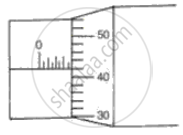Advertisements
Advertisements
प्रश्न
What is meant by zero error of vernier callipers ? How is it determined? Draw neat diagrams to explain it. How is it taken in account to get the correct measurement?
उत्तर
Due to mechanical errors, sometimes the zero mark of the vernier scale does not coincide with the zero mark of the main scale, the vernier callipers is said to have zero error.
It is determined by measuring the distance between the zero mark of the main scale and the zero mark of the vernier scale.
The zero error is of two kinds
(i) Positive zero error
(ii) Negative zero error
(i) Positive zero error: On bringing the two jaws together, if the zero mark of the vernier scale is on the right of the zero mark of the main scale, the error is said to be positive.

To find this error, we note the division of the vernier scale, which coincides with any division of the main scale. The number of this vernier division when multiplied by the least count of the vernier callipers, gives the zero error.
For example, for the scales shown, the least count is 0.01 cm and the 6th division of the vernier scale coincides with a main scale division.
Zero error = +6 × L.C. = +6 × 0.01 cm
= +0.06 cm
(ii) Negative zero error: On bringing the two jaws together, if the zero mark of the vernier scale is on the left of the zero mark of the main scale, then the error is said to be negative.

To find this error, we note the division of the vernier scale coinciding with any division of the main scale. The number of this vernier division is subtracted from the total number of divisions on the vernier scale and then the difference is multiplied by the least count.
For example, for the scales shown, the least count is 0.01 cm and the sixth division of the vernier scale coincides with a certain division of the main scale. The total number of divisions on vernier callipers is 10.
Zero error = - (10 - 6) × L.C.
= - 4 × 0.01 cm = - 0.04 cm
Correction:
To get correct measurement with vernier callipers having a zero error, the zero error with its proper sign is always subtracted from the observed reading.
Correct reading = Observed reading - zero error (with sign)
APPEARS IN
संबंधित प्रश्न
Name the two scales of a vernier callipers and explain how it is used to measure length correct up to 0.01 cm.
In the vernier callipers, there are 10 divisions on the vernier scale and 1 cm on the main scale is divided into 10 parts. While measuring the length, the zero of the vernier lies just ahead of the 1.8 cm mark and the 4th division of vernier coincides with a main scale division.
(a) Find the length.
(b) If zero error of vernier callipers is -0.02 cm,
What is the correct length ?
The pitch of a screw gauge is 0.5 mm and the head scale is divided in 100 parts. What is the least count of a screw gauge?
The least count of a vernier callipers is 0.0025 cm and it has an error of + 0.0125 cm. While measuring the length of a cylinder, the reading on the main scale is 7.55 cm, and the 12th vernier scale division coincides with the main scale. Calculate the corrected length.
State the formula for determining least count for a vernier callipers.
Which part of vernier callipers is used to measure the internal diameter of a hollow cylinder?
The circular scale of a screw gauge has 100 divisions. Its spindle moves forward by 2.5 mm when given five complete turns. Calculate
- pitch
- least count of the screw gauge
What do you understand by the term least count of screw?
State whether the following statement is true or false by writing T/F against it.
A metre scale can measure a length of 6.346 cm.
What is meant by the pitch of a screw gauge? The pitch of a screw is 1 mm.
Find the reading of the instrument shown in the following figure.

